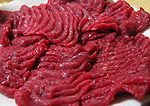Ok so today Jeanna and I were texting each other and I stated I was so hungry I could eat a horse……to which she replied that she wasn’t sure how to prepare horse meat but she’d Google it…….so when I got home I did just that. Now I am blogging about it because I just cannot believe there is that much info out there regarding the preparation of horse meat. However, I have eaten ostrich, alligator, cow, lamb, chicken, turkey………why is eating horse really that far of a stretch of one’s imagination, it is after all just another animal??
I really don’t have more to say on the topic so I’ll leave you with excerpts from the fact based (or so it proclaims) posting from Wikipedia……link also included in case its hard to read as it posted. Oh and one more point to note: horse meat IS consumed in Iceland maybe, just maybe, I’ll have a chance to try it?
http://en.wikipedia.org/wiki/Horse_meat
Horse meat
Horse meat is the culinary name for meat cut from a horse. It is a major meat in only a few countries, notably in Central Asia, but it forms a significant part of the culinary traditions of many others, from Europe to South America to Asia, the top eight countries consuming about 4.7 million horses a year. For the majority of mankind’s early existence wild horses were hunted as a source of protein.[1][2] According to Viande Richelieu, one of the largest North American horse meat exporters, it is slightly sweet, tender, low in fat, and high in protein.[3]
However, because of the role horses have played as a companion and as a worker, and concerns about the ethics of the horse slaughter process, it is a taboo food in some cultures. These historical associations, as well as ritual and religion, led to the development of the aversion to the consumption of horse meat. The horse is now given pet status by many in some parts of the western world (particularly in the USA and UK), which further solidifies the taboo on eating its meat. This avoidance (and the loss of taste for it) is relatively modern, although it arises out of complex historical and cultural origins.
Horse meat in various countries
Mongolia
Mongolia, a nation famous for its nomadic pastures and equestrian skills, also includes horse meat on the menu. Mongolians also make a horse milk wine, called airag. Salted horse meat sausages called kazy are produced as a regional delicacy by the Kazakhs in Bayan-Ölgii aimag.[50] In modern times, Mongols prefer beef and mutton, though during the extremely cold Mongolian winter, many people prefer horse meat due to its low cholesterol . It is kept non-frozen and traditionally people think horse meat helps warms them up.
Other Asian nations import processed horse meat from Mongolia
Iceland
In Iceland it is both eaten minced and as steak, also used in stews and fondue, prized for its strong flavor. It has a particular role in the culture and history of the island, as its consumption was one of the concessions won when the pagan Norse Icelanders eventually adopted Christianity in the year 1000.
United Kingdom
In the United Kingdom the slaughter, preparation and consumption of horses for food is not against the law, although in practice it has been out of fashion since the 1930s and there is a strong taboo against it. It was eaten when other meats were scarce, such as during times of war[61][62] (as was whale meat, never popular and now also taboo). The sale of horse meat in supermarkets and butchers is minimal, and most of the horse meat consumed in the UK is imported from Europe, predominantly the South of France, where it is more widely available.[63] Horse meat may be consumed inadvertently. A 2003 Food Standards Agency investigation revealed that salami and similar products such as chorizo and pastrami sometimes contain horse meat, without this ingredient being listed.[64] Listing is legally required.[65]
North America
Canada
Agriculture in Quebec seems to prosper under the prohibitions from the United States. There is a thriving horse meat business in Quebec; the meat is available in most supermarket chains. Horse meat is also for sale at the other end of the country, in Granville Island Market in downtown Vancouver where, according to a Time magazine reviewer who smuggled it into the United States, it turned out to be a “sweet, rich, superlean, oddly soft meat, closer to beef than venison”.[12] Horse meat is also available in high end Toronto butchers and supermarkets. Aside from the heritage of French cuisine at one end of the country and the adventurous foodies of Vancouver at the other, however, the majority of Canada shares the horse meat taboo with the rest of the Anglosphere. This mentality is especially evident in Alberta, where strong horse racing and breeding industries and cultures have existed since the province’s founding.
United States
Horse meat is rarely eaten in the United States. Horses are raised instead as pets, for working purposes (border patrol, police work, and ranching), or for sport. Horse meat holds a very similar taboo in American culture, the same as the one found in the United Kingdom previously described, except that it is rarely even imported.
Restriction of human consumption of horse meat in the U.S. has generally involved legislation at the state and local levels. In 1915, for example, the New York City Board of Health amended the sanitary code, making it legal to sell horse meat.[66] During World War II, due to the low supply and high price of beef, New Jersey legalized its sale, but at war’s end, the state again prohibited the sale of horse meat.
In 1951, Time magazine reported from Portland, Ore.: “Horsemeat, hitherto eaten as a stunt or only as a last resort, was becoming an important item on Portland tables. Now there were three times as many horse butchers, selling three times as much meat.” Noting that “people who used to pretend it was for the dog now came right out and said it was going on the table,” and providing tips for cooking pot roast of horse and equine fillets. A similar situation unfolded in 1973, when inflation raised the cost of traditional meats. Time reported that “Carlson’s, a butcher shop in Westbrook, Conn., that recently converted to horse meat exclusively, now sells about 6,000 pounds of the stuff a day.” The shop produced a 28-page guide called “Carlson’s Horsemeat Cook Book,” with recipes for chili con carne, German meatballs, beery horsemeat, and more.
Harvard University‘s Faculty Club had horse meat on the menu for over one hundred years, until 1985.
Until 2007, a few horse meat slaughterhouses still existed in the United States, selling meat to zoos to feed their carnivores, and exporting it for human consumption, but the last one, Cavel International in Dekalb, Illinois was closed by court order in 2007.[70][71] The closure reportedly caused a surplus of horses in Illinois.





